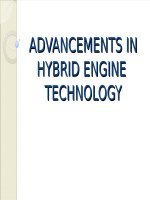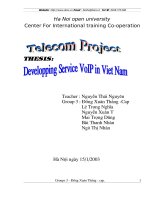Engine Bottom End Service
Bạn đang xem bản rút gọn của tài liệu. Xem và tải ngay bản đầy đủ của tài liệu tại đây (4 MB, 85 trang )
by
Russell Krick
Publisher
The Goodheart-Willcox Co., Inc.
Tinley Park, Illinois
© Goodheart-Willcox Co., Inc.
Permission granted to reproduce for educational use only
© Goodheart-Willcox Co., Inc.
Permission granted to reproduce for educational use only
(11 Topics)
Cylinder block service
Balancer shaft service
Piston service
Piston pin service
Connecting rod service
Piston ring service
© Goodheart-Willcox Co., Inc.
Permission granted to reproduce for educational use only
Crankshaft service
Installing a piston and rod assembly
Torque-to-yield bolts
Engine balancing
Final assembly of engine
© Goodheart-Willcox Co., Inc.
Permission granted to reproduce for educational use only
Common block service tasks:
check the block for cracks and distortion
inspect the cylinders for damage
measure the cylinders for wear
hone or deglaze the cylinder walls
clean the cylinders after honing
install core plugs
© Goodheart-Willcox Co., Inc.
Permission granted to reproduce for educational use only
Parts Requiring
Service
© Goodheart-Willcox Co., Inc.
Permission granted to reproduce for educational use only
Block Pressure Testing
To make sure the block is not cracked:
block all passages
submerge the block in a water tank
force compressed air into the passages
cracks or pores will show up as air
bubbles leaking out of the block
© Goodheart-Willcox Co., Inc.
Permission granted to reproduce for educational use only
Checking Main Bores
Overheating can cause the block to
warp or twist, causing main bearing
alignment problems
Check with a straightedge and feeler
gauge
lay the straightedge on the bores
slide the feeler gauge between the
straightedge and bores
© Goodheart-Willcox Co., Inc.
Permission granted to reproduce for educational use only
Checking Main Bores
The thickest feeler gauge that fits
equals the misalignment
© Goodheart-Willcox Co., Inc.
Permission granted to reproduce for educational use only
Boring Bar
Used to true up
the block’s main
bore
© Goodheart-Willcox Co., Inc.
Permission granted to reproduce for educational use only
Measuring Deck
Warpage
Measure with a straightedge and feeler
gauge on the head gasket surface
lay a straightedge on the clean block
surface
slide a feeler gauge between the
straightedge and block
the thickest feeler gauge that fits
indicates warpage
© Goodheart-Willcox Co., Inc.
Permission granted to reproduce for educational use only
Measuring Deck
Warpage
Maximum allowable warpage is about
0.003"–0.005" (0.08 mm–0.13 mm)
© Goodheart-Willcox Co., Inc.
Permission granted to reproduce for educational use only
Milling Machine
Used to resurface cylinder block decks
and cylinder heads
© Goodheart-Willcox Co., Inc.
Permission granted to reproduce for educational use only
Thread Cleaning and
Repair
Run a tap through threaded holes to
remove debris and repair threads
© Goodheart-Willcox Co., Inc.
Permission granted to reproduce for educational use only
Cylinder Wear
Cylinder taper
difference in diameter at the top and
bottom of the cylinder
caused by less lubrication at the top
Cylinder out-of-roundness
difference in diameters measured front-torear and side-to-side
piston thrust action makes the cylinder
wear more at right angles to the
crankshaft
© Goodheart-Willcox Co., Inc.
Permission granted to reproduce for educational use only
Cylinder
Bore Gauge
Slide the gauge up
and down the cylinder
Indicator movement
indicates changes in
diameter
© Goodheart-Willcox Co., Inc.
Permission granted to reproduce for educational use only
Cylinder Taper
More wear at the top of the cylinder
© Goodheart-Willcox Co., Inc.
Permission granted to reproduce for educational use only
Cylinder
Measurements
Measuring taper and out-of-round
© Goodheart-Willcox Co., Inc.
Permission granted to reproduce for educational use only
Cylinder Honing
Trues worn cylinders
Breaks the glaze on used cylinders
before installing new rings
Smoothes rough cylinders after boring
Most hones are used in a large, lowspeed electric drill
© Goodheart-Willcox Co., Inc.
Permission granted to reproduce for educational use only
Brush Hone
Used for light honing to restore surface
© Goodheart-Willcox Co., Inc.
Permission granted to reproduce for educational use only
Rigid Hone
(Sizing Hone)
The adjustable stones lock into a preset
position
Removes some taper and out-of-round
© Goodheart-Willcox Co., Inc.
Permission granted to reproduce for educational use only
Honing Machine
Used to rigid hone the cylinders
© Goodheart-Willcox Co., Inc.
Permission granted to reproduce for educational use only
Honing a Cylinder
Move the hone up and down fast enough
to produce a 50º–60º crosshatch pattern
© Goodheart-Willcox Co., Inc.
Permission granted to reproduce for educational use only
Cleaning Cylinder
Walls
It is very important to remove all honing
grit
Grit can act like grinding compound on
internal engine parts
Wash out the cylinders with soap and
water
Wipe the cylinders down with an oily
rag until they are perfectly clean
© Goodheart-Willcox Co., Inc.
Permission granted to reproduce for educational use only
Cylinder Block Boring
Removes deep scratches, scoring, or
excess wear
After boring, oversize pistons must be
used
The “overbore limit” is the largest
allowable diameter increase
typically 0.030"–0.060"
© Goodheart-Willcox Co., Inc.
Permission granted to reproduce for educational use only









